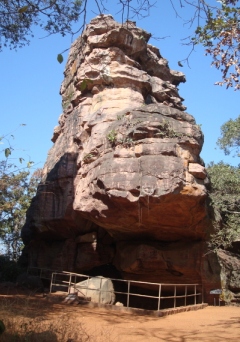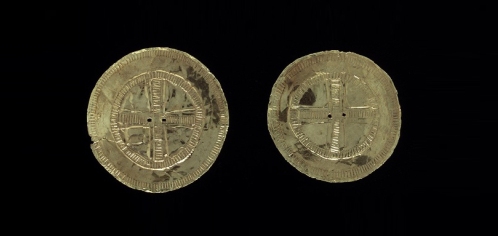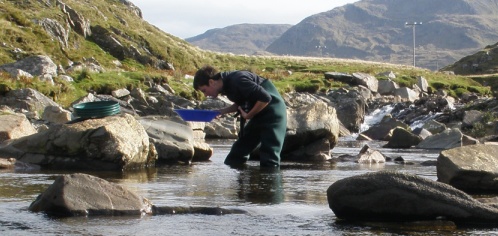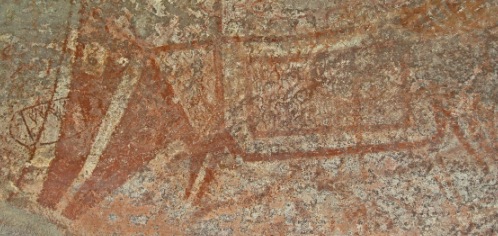Isotopes and archaeology
- Origin and chronology of modern humans
- Prehistoric mobility and subsistence
- Provenance of prehistoric metals
Origin and chronology of modern humans
Many of the major events in human evolution, such as the rise of Neanderthals in Eurasia, occurred during the Middle Pleistocene. This period of time, somewhat inconveniently, lies between the ranges of the commonly applied 14C and 40Ar-39Ar geochronometers. Any models of the origin and radiation of modern humans must, however, be accurately pinned by good absolute chronological constraints. Uranium-series dating of human bone using laser ablation MC-ICPMS is a technique that can potentially plug this gap.
Unlike most precipitated calcites, bone is an open system with respect to uranium. Any attempt to calculate an age from the measured 230Th/U requires the modelling of the uranium uptake (or loss) from the bone. We use the diffusion adsorption (D-A) model to account for this uranium migration. The D-A model predicts the distributions (profiles) of uranium and U-series isotopes across a bone section. It has been shown how these distributions reflect the uranium uptake history of a bone, with events such as the leaching of uranium or recent increased uranium uptake leading to characteristic profiles.
The key to uranium-series dating with the D-A model is to select bones on the basis of their profiles that have undergone uranium uptake under relatively constant geochemical conditions, and to reject those that have complex uptake regimes. At the BIG, uranium-series isotopes are measured across a bone using laser-ablation MC-ICPMS using well-characterized bones as calibration standards. Typically, a precision of a few percent is achieved on bones with circa 5 ppm uranium. We are currently involved in a number of projects focusing on the chronology of human evolution.
Prehistoric mobility and subsistence
The reconstruction of past diet is extremely important in understanding past societies since there are few, if any, aspects of past culture that are not influenced, or informed, by the need to procure food. Changes in subsistence strategies are often accompanied by major changes in material culture and inferred social organization.
Analysis of stable isotopes in human bone collagen and characterization of lipid residues in pottery have vastly improved our understanding of past diet, but both have their limitations. Our approach at the BIG is to augment the existing palaeodietary record using micro-sampling of incremental structures in teeth to characterize patterns of subsistence behaviour within a person's lifetime.
The incremental nature of tooth enamel (and other structures) allows the measurement of a time-series of isotopic proxies for diet (e.g. δ13C), annual seasonal cycle (δ18O) and geographical location (87Sr/86Sr) that will allow the reconstruction of aspects of an individual’s life history that would otherwise be invisible in the archaeological record.
At the BIG we use Sr/Ca as a proxy for dietary intake and Sr isotopes as a proxy for transhumance and migration. Strontium isotopes that vary with the underlying geology are incorporated into teeth from the diet.
Because teeth grow incrementally, analysis of Sr isotopes at a high spatial resolution along the axis of growth gives a picture of the mobility of humans in the past. We are currently developing methods to measure Sr isotopes in teeth at the required spatial resolution using laser ablation MC-ICPMS and micromilling in order to study changing subsistence behaviours at the Mesolithic-Neolithic transition.
Provenance of prehistoric metals
Lead isotopes have the advantage over other attempts to identify the source of metals, because the isotopic signature is preserved through each stage of processing of the ore and smelting the metal. The ratios of 208Pb/206Pb, 207Pb/206Pb and 206Pb/204Pb of an ore body are a function of its geochemical history.
The isotopes 206Pb, 207Pb, and 208Pb are the stable radiogenic products of the decay series with 238U, 235U, and 232Th parents, and thus will be in different ratios for deposits of different ages and different parent compositions. Where ore bodies have been sufficiently well characterised isotopically, and where the suite of lead isotopes is sufficiently distinct from other ore bodies, artefacts can be attributed to that source with only a small degree of uncertainty.
Working in this area




